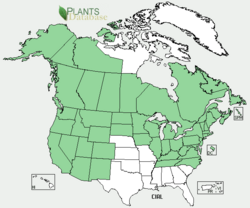Biology:Circaea alpina
| Enchanter's nightshade | |
|---|---|

| |
| Scientific classification | |
| Kingdom: | Plantae |
| Clade: | Tracheophytes |
| Clade: | Angiosperms |
| Clade: | Eudicots |
| Clade: | Rosids |
| Order: | Myrtales |
| Family: | Onagraceae |
| Genus: | Circaea |
| Species: | C. alpina
|
| Binomial name | |
| Circaea alpina | |

| |
| Range within North America | |
Circaea alpina, commonly called alpine enchanter's nightshade or small enchanter's nightshade, is a 10–30 cm tall perennial herb found in cool forests of the Northern Hemisphere.[1][2]
Description
The leaves are opposite, ovate, 2–6 cm and coarsely dentate. The 1.5–4 cm (0.6–1.6 in) petioles have a wing beneath. The flowers and fruits are clustered near the top of the fruiting raceme; each raceme bears 15 or less white or pink flowers in mid-May through early September.[3][4][5] Each flower has two white to light pink petals 1–1.5 mm (0.04–0.06 in) long with two lobes. The two white sepals are 1–2 mm (0.04–0.08 in) long.[3] The fruit is a small bur with one seed. C. alpina can reproduce vegetatively and via stolons.[2]
Distribution
In North America, Circaea alpina is distributed throughout all of Canada and North Carolina through Maine and New Mexico through Washington.[6][7] In Eurasia, the range of C. alpina includes Northern Europe south to Albania and Bulgaria and east to Korea and Japan.[1] C. alpina prefers a moist, upland habitat.[8] It is generally found in forests or near streams from sea level to 3,000 metres (10,000 ft).[6]
Hybrids
Circaea alpina will hybridize with Circaea lutetiana producing sterile offspring that persists in vegetative colonies.[8]
References
- ↑ 1.0 1.1 "Species details : Circaea alpina". http://www.catalogueoflife.org/col/details/species/id/58dd3fa0afa855c81898905c8a485202. Retrieved 2016-08-02.
- ↑ 2.0 2.1 "Alpine Enchanter's Nightshade". http://www.luontoportti.com/suomi/en/kukkakasvit/alpine-enchanters-nightshade. Retrieved 2016-08-02.
- ↑ 3.0 3.1 Klinkenberg, Brian, ed (2014). "Circaea alpina". Lab for Advanced Spatial Analysis, Department of Geography, University of British Columbia, Vancouver. http://linnet.geog.ubc.ca/Atlas/Atlas.aspx?sciname=Circaea%20alpina. Retrieved 2016-08-02.
- ↑ Giblin, David, ed (2015). "Circaea alpina". Burke Museum, University of Washington. http://biology.burke.washington.edu/herbarium/imagecollection.php?Genus=Circaea&Species=alpina. Retrieved 2016-08-02.
- ↑ "Circaea alpina". Jepson Herbarium; University of California, Berkeley. 2015. http://ucjeps.berkeley.edu/cgi-bin/get_IJM.pl?tid=Circaea%20alpina. Retrieved 2016-08-02.
- ↑ 6.0 6.1 Sullivan, Steven. K. (2015). "Circaea alpina". http://www.wildflowersearch.com/search?&PlantName=Circaea+alpina. Retrieved 2016-08-02.
- ↑ "Circaea alpina". United States Department of Agriculture; Natural Resources Conservation Service. 2015. http://plants.usda.gov/java/profile?symbol=CIAL. Retrieved 2016-08-02.
- ↑ 8.0 8.1 Rhoads, Block (2007-09-05). The Plants of Pennsylvania (2 ed.). ISBN 978-0-8122-4003-0.
External links
Wikidata ☰ Q159427 entry

